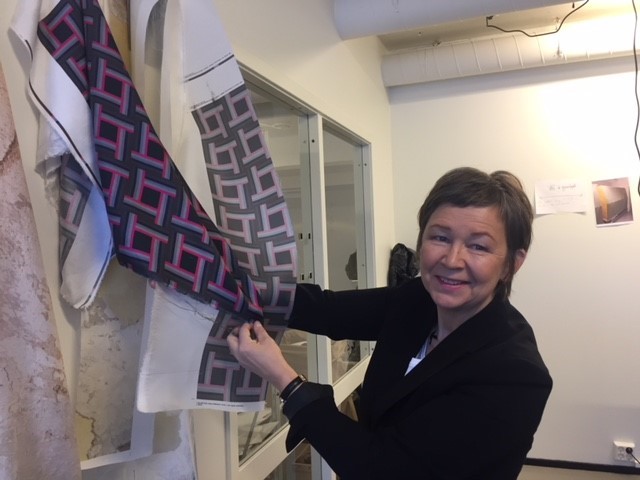Erasmus+ staff exchange resulted in a new textile printer, and unforeseen opportunities for professional development and collaboration
Why University of Wales Trinity Saint David, Swansea College of Art?
It all started with a visit from Swansea College of Art to the Department of Product Design, and a catalogue they left behind.
At Swansea College of Art, they have a degree in Surface Pattern Design and Textiles (MDes/BA Surface Pattern Design), and over the years, they have educated the best designers within textile when it comes to interiour and fashion, and design for galleries and for the major commercial brands.
They also have their own department called Cerebra that works with projects for users with special needs. There they design products that make life better for those who need it most.
My motivation for traveling to Swansea was to get a chance to learn more about patterning on surfaces, and to work with patterns on textiles, wood, metal, and ceramics. I also hoped that this would increase the focus on textile in the study programme.
At Swansea, they have an impressive collection of digital laser cutters and engraving machines, 3D printer for plastics, powder and ceramics, digital textile printers, digital embroidery machines and water jet cutter.
During my stay, they gave me the opportunity to build patterns and make use of many of the machines.
The Head of the Department of Product Design was interested and committed, and encouraged me to travel, which I really appreciated.
Preparations
I contacted Swansea College of Art, and presented my wishes for the stay. They were very accommodating, and put together a programme based on my wishes, with workshops and training, as well as time to learn more about surface pattern design in the Illustrator programme.
I put a lot of energy into my preparations to get the most out of the stay. This meant getting to know the institution I was going to visit, and the surroundings. I also took with me my gear and some materials, so that I could work on creating new patterns when I had some time for myself.
Here is a pattern of paper strips that are shuffled, reported, inverted and printed on wool.

What did I do during my stay?
I attended many workshops to learn different techniques. I also had time to practice what I learned, and this worked very well. There were workshops on textile printing, laser engraving and cutting, sandblasting on textile, glass, leather and tile, and the training was thorough.
I got to try 3D printing, and did a project based on my father´s lace, that resulted in an anti-slip product.

How did the stay influence my competences?
During my stay, I have gained a broader understanding of patterns and surfaces, and the relevance of this. I am more confident now in my role as a lecturer for the students, and I got many ideas for interdisciplinary collaboration at the faculty, and for further international cooperation.
I now see the possibilities of the machine park, and I have also improved my English skills.
What specific results can be identified at the Department of Product Design as a direct consequence of the exchange?
Back home, I gave lectures for my colleagues at the Department of Product Design about everything I had learned, and we all agreed, “We must have a textile printer like the one they have in Swansea!”

Such a machine is a big boost for the textile section at the Department of Product Design, and leads to an increase in competence for the entire department, and for the students.
They get a unique opportunity to increase the understanding of patterns and surfaces, to see how the products they make in textile are transferable to other material areas, and in the end to a product. They gain experience in making their own aesthetic assessments. It is crucial to train the eyes to understand aesthetics in order to create attractive products for the users.
We have plans to create our own projects for the students, and organise "print-evenings" at the Department of Product Design, where employees also can try the machine.
The machine will be a collaboration with the Department of Aesthetics, and the study programme Fashion and Production.
It also provides opportunities for international cooperation. We are planning a visit from Swansea to a workshop arranged by the Department of Product Design, and there are plans for further cooperation. At the same time, we are exploring the possibilities of developing a strategic partnership project within the Erasmus + program with relevant European partner institutions.

I am very pleased with the experiences from the Erasmus + staff exchange in Swansea, and the impact it had on the development of own competences, and on the professional development of the textile section at the Department of Product Design. I would like to do it again!
